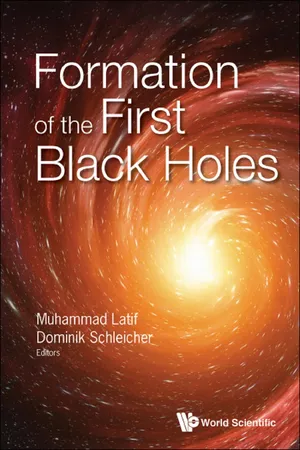
- 376 pages
- English
- ePUB (mobile friendly)
- Available on iOS & Android
Formation of the First Black Holes
About this book
The formation of the first supermassive black holes is one of the main open questions in our understanding of high-redshift structure formation. In this book, we aim to provide a summary of state-of-the-art modern research on this topic, exploring the formation of massive black holes from a fluid-dynamical, stellar-dynamical and chemical perspective. The book thus presents a solid theoretical foundation, a comparison with current observations and future observational perspectives with upcoming missions such as the Square Kilometre Array, the European Extremely Large Telescope, the Euclid satellite as well as possible detections via gravitational waves.
Contents:
- Astrophysical Black Holes (Pedro R Capelo)
- Formation and Evolution of the Cosmic Large-Scale Structure (Björn M Schäfer)
- Thermodynamics and Chemistry of the Early Universe (Stefano Bovino & Daniele Galli)
- Formation of the First Stars (Ralf Klessen)
- Black Hole Formation via Gas-Dynamical Processes (Muhammad A Latif)
- Primordial Gas Collapse in the Presence of Radiation: Direct Collapse Black Hole or Population III Star? (Bhaskar Agarwal)
- Black Hole Formation in the First Stellar Clusters (Harley Katz)
- Evolution and Final Fates of Rapidly Accreting Supermassive Stars (Takashi Hosokawa)
- Statistical Predictions for the First Black Holes (Tilman Hartwig)
- Growth and Feedback from the First Black Holes (John H Wise)
- Super-Eddington Accretion; Flow Regimes and Conditions in High-Z Galaxies (Lucio Mayer)
- Current Observational Status (Dominik R G Schleicher)
- Probing the Formation of the Seeds of Supermassive Black Holes with Gravitational Waves (Monica Colpi)
- Prospects for Detecting the First Black Holes with the Next Generation of Telescopes (Mark Dijkstra)
Readership: Graduate students and professionals in cosmology.Black Holes;Cosmology;Early Universe0 Key Features:
- Provides the first and foremost overview on the formation mechanisms of the first supermassive black holes
- Includes a detailed treatment of the many physical processes that are relevant for the formation of the first black holes, including chemical and thermodynamical aspects as well as gas and stellar dynamics
- Provides an important outlook on future observational perspectives from both space- and ground-based missions, including the Square Kilometer Array, the European Extremely Large Telescope and the Euclid satellite, as well as the future prospects from the detection of gravitational waves
Frequently asked questions
- Essential is ideal for learners and professionals who enjoy exploring a wide range of subjects. Access the Essential Library with 800,000+ trusted titles and best-sellers across business, personal growth, and the humanities. Includes unlimited reading time and Standard Read Aloud voice.
- Complete: Perfect for advanced learners and researchers needing full, unrestricted access. Unlock 1.4M+ books across hundreds of subjects, including academic and specialized titles. The Complete Plan also includes advanced features like Premium Read Aloud and Research Assistant.
Please note we cannot support devices running on iOS 13 and Android 7 or earlier. Learn more about using the app.
Information
Chapter 1
Astrophysical black holes
Institute for Computational Science
University of Zurich
Winterthurerstrasse 190, CH-8057 Zürich, Switzerland
[email protected]
1.The concept of a black hole and the first predictions












Table of contents
- Cover
- Halftitle
- Title
- Copyright
- Preface
- Contents
- 1. Astrophysical black holes
- 2. Formation and evolution of the cosmic large-scale structure
- 3. Thermodynamics and chemistry of the early universe
- 4. Formation of the first stars
- 5. Black hole formation via gas-dynamical processes
- 6. Primordial gas collapse in the presence of radiation: direct collapse black hole or Population III star?
- 7. Black hole formation in the first stellar clusters
- 8. Evolution and final fates of rapidly accreting supermassive stars
- 9. Statistical predictions for the first black holes
- 10. Growth and feedback from the first black holes
- 11. Super-Eddington accretion; flow regimes and conditions in high-z galaxies
- 12. Current observational status
- 13. Probing the formation of the seeds of supermassive black holes with gravitational waves
- 14. Prospects for detecting the first black holes with the next generation of telescopes
- References
- Index